
Полезное:
Как сделать разговор полезным и приятным
Как сделать объемную звезду своими руками
Как сделать то, что делать не хочется?
Как сделать погремушку
Как сделать так чтобы женщины сами знакомились с вами
Как сделать идею коммерческой
Как сделать хорошую растяжку ног?
Как сделать наш разум здоровым?
Как сделать, чтобы люди обманывали меньше
Вопрос 4. Как сделать так, чтобы вас уважали и ценили?
Как сделать лучше себе и другим людям
Как сделать свидание интересным?

Категории:
АрхитектураАстрономияБиологияГеографияГеологияИнформатикаИскусствоИсторияКулинарияКультураМаркетингМатематикаМедицинаМенеджментОхрана трудаПравоПроизводствоПсихологияРелигияСоциологияСпортТехникаФизикаФилософияХимияЭкологияЭкономикаЭлектроника

Обзор аномальных свидетельств о существовании человека в глубокой древности
|
|
Находки, упомянутые в этой книге, расположены в соответствии с их возрастом, опубликованные сведения о котором авторы считают наиболее достоверными либо заслуживающими внимания. Ниже приводятся значения терминов, использованных в данной таблице:
эолиты – осколки камня естественного происхождения с намеренно заостренным либо сточенным от долгого употребления краем или краями;
палеолиты – камни, обработанные таким образом, что можно их признать орудиями труда;
неолиты – наиболее совершенные каменные орудия труда и приспособления;
человеческий – классифицированный по меньшей мере несколькими исследователями как соответствующий анатомии современного человека;
надрезанные, разрубленные, гравированные или заостренные кости – кости животных, обработанные с определенной целью.
ЧАСТЬ I. Обзор аномальных свидетельств о существовании человека в глубокой древности (Общая часть)
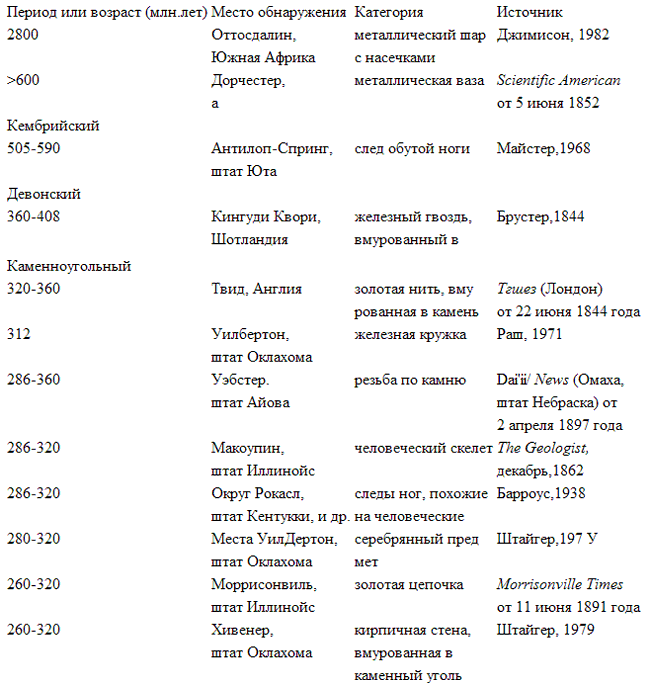
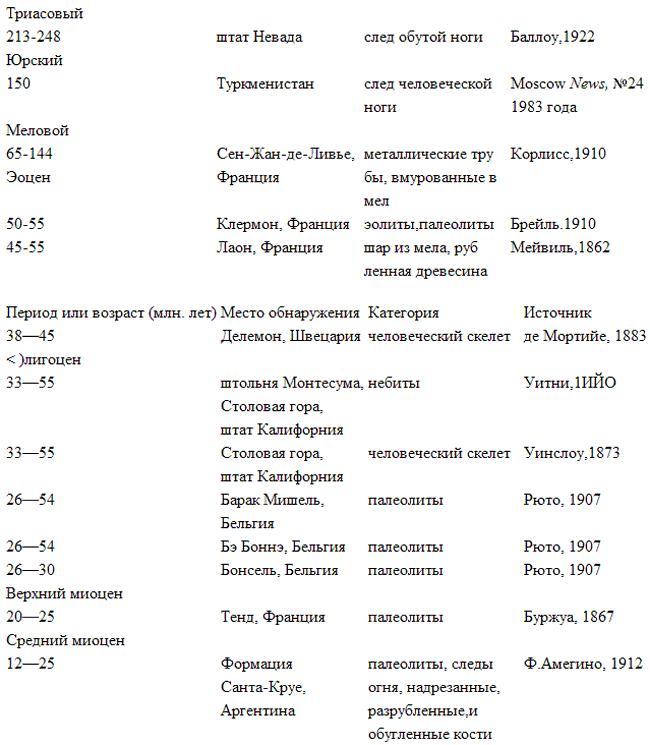
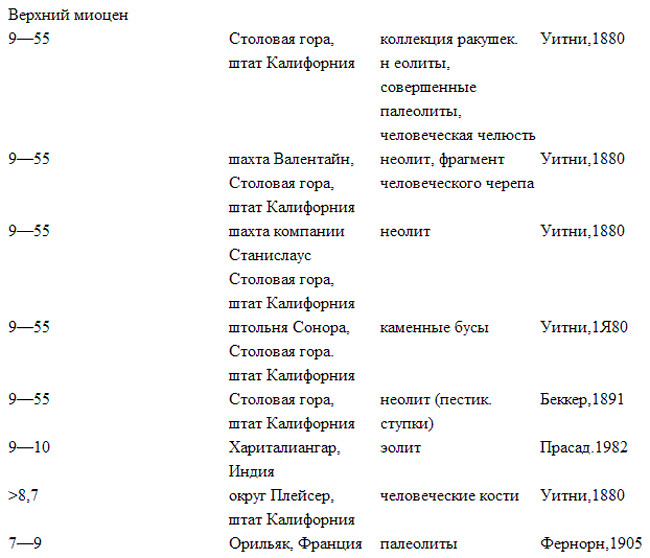

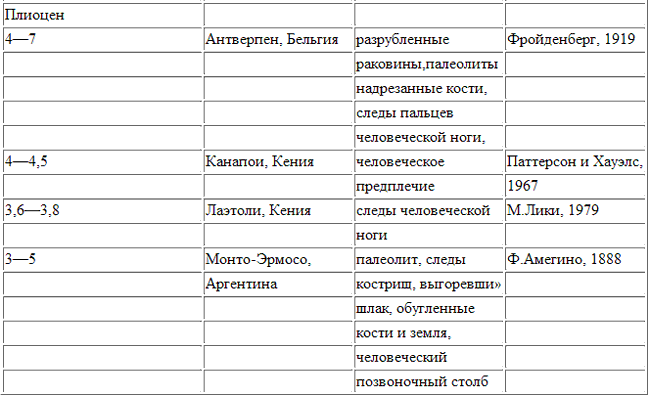
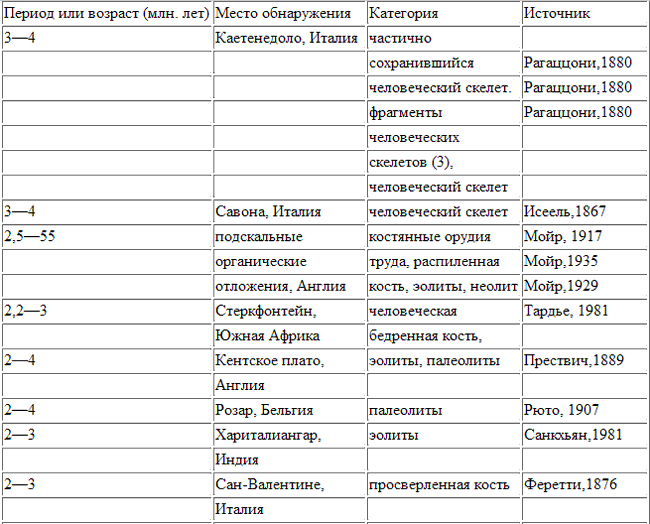
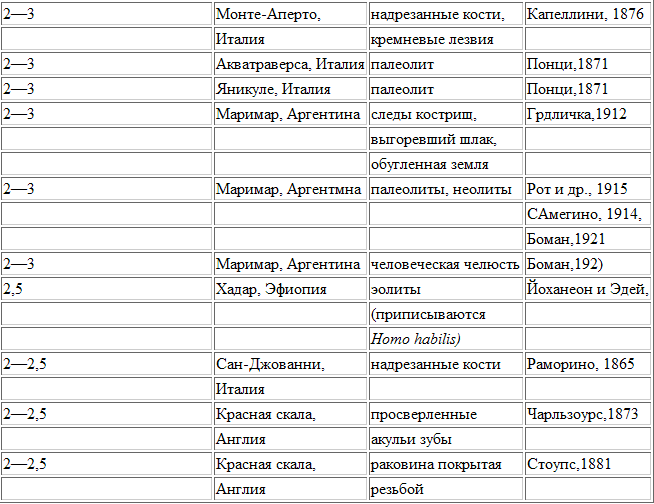
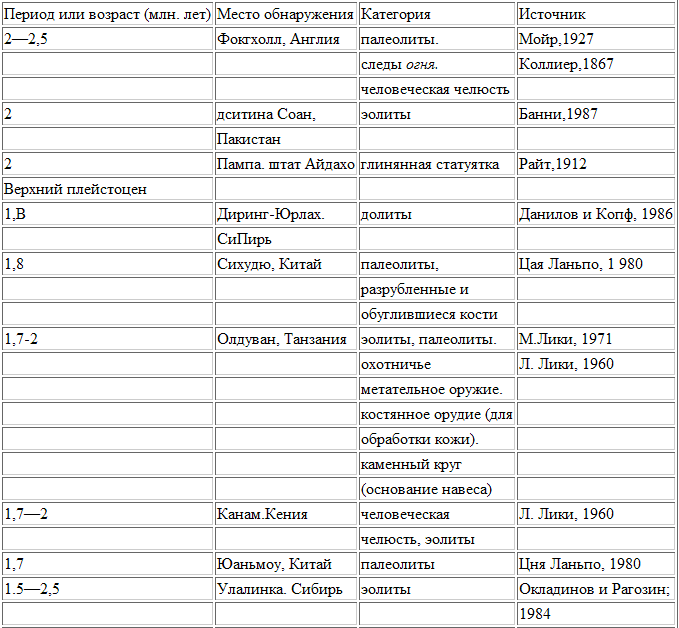
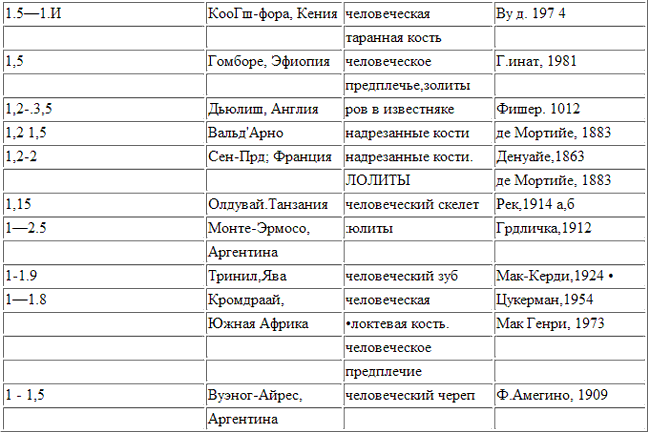
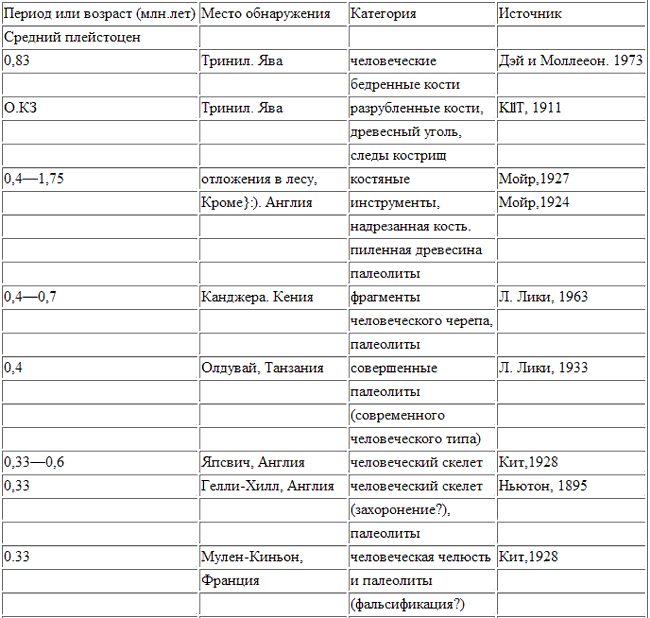
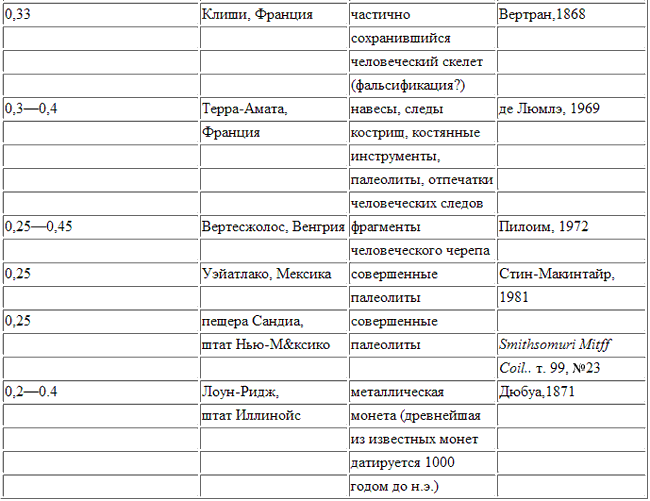

Перечисленные ниже находки, датируемые плейстоценом, могут считаться аномальными лишь для Северной и Южной Америки. По мнению подавляющего большинства ученых, первые люди появились в Северной Америке не ранее 12 000 (0, 012 миллиона) лет назад. Знак вопроса указывает на то, что последующее применение радиоактивно‑углеродистого метода позволило уточнить их возраст, оказавшийся менее 10 000 лет.
ЧАСТЬ II. Обзор аномальных свидетельств о существовании человека в глубокой древности (Только по Северной и Южной Америке)
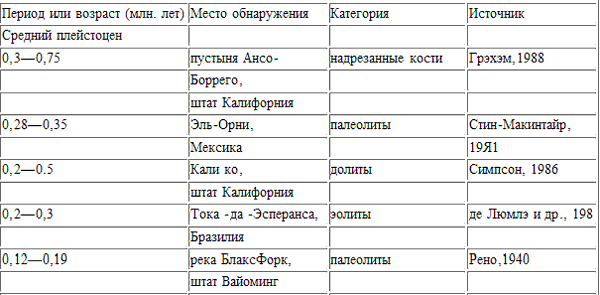
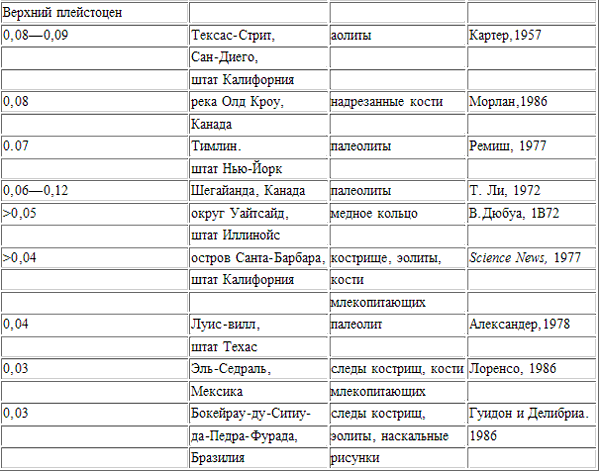
Библиография
Aigner, J. S. (1978) Pleistocene faunal and cultural stations in south China. In Ikawa‑Smith, F., ed. Early Paleolithic in South and East Asia. The Hague, Mouton pp. 129–162.
Aigner, J. S. (1981) Archaeological Remains in Pleistocene China. Munich, С. Н. Beck.
Aigner, J. S., and Laughton, W. S. (1973) The dating of Lantian man and his significance for analyzing trends in human evolution. American Journal of Physical Anthropology, 39(1): 97‑110.
Alexander, Н. L. (1978) The legalistic approach to early man studies. In Bryan, A. L., ed. Early Man in America from a Circum‑Pacific Perspective. Edmonton, Archaeological Researches International, pp. 20‑22.
Alsoszatai‑Petheo, J. (1986) An alternative paradigm for the study of early man in the New World. In Bryan, A. L., ed. New Evidence for the Pleistocene Peopling of the Americas. Orono, Maine, Center for the Study of Early Man, pp. 15‑26.
Ameghino, C. (1915) El femur de Miramar, Anales delMuseo nacionalde historia natural de Buenos Aires. 26: 433–450. (*)
Ameghino. F. (1908) Notas preliminares sobre el Tetraprothomo argentinus. un precursor del hombre del mioceno superior de Monte Hennoso. Anales del Museo nacional de historia natural de Buenos Aires, 16: 105–242. (*)
Ameghino, F. (1909) Le Diprothomo platensis, un precurseur de 1'homme du pliocene inferieur de Buenos Aires. Anales del Museo nacional de historia natural de Buenos Aires, 19: 107–209. (*)
Ameghino, F. (1910a) Vestigios industriales en el eoceno superior de Patagonia. Report to Congreso cientifico internacional americano, Buenos Aires, July 10‑25, 1910, 8 pp.
Ameghino, F. (191 Ob) Vestigios industriales en la formation entrerriana (oligoceno superiorбmioceno elmds inferior). Report to Congreso cientifico internacional americano, Buenos Aires, July 10‑25, 1910, 8 pp.
Ameghino, F. (1911) Enumeration chronologique et critique des notices sur les terres cuites et les scories anthropiques des terrains sedimentaires neogenes de 1'Argentine panics jusqu'a la fin de 1'annee 1907. Anales del Museo nacional de historia natural de Buenos Aires, 20: 39‑80. (*)
Ameghino, F. (1912) L'age des formations sedimentaires tertiaires de 1'Argentine en relation avec 1'antiquite de 1'homme. Anales del Museo nacional de historia natural de Buenos Aires, 22: 45‑75. (*)
Anderson, E. (1984) Who's who in the Pleistocene: a mammalian bestiary. In Martin, P. S., and Klein, R. G., eds. Quaternary Extinctions. Tucson, University of Arizona Press, pp. 40‑90.
Ayres, W. 0. (1882) The ancient man of Calaveras. American Naturalist,
Aigner, J. S. (1978) Pleistocene faunal and cultural stations in south China. In Ikawa‑Smith, F., ed. Early Paleolithic in South and East Asia. The Hague, Mouton, pp. 129–162.
Aigner, J. S. (1981) Archaeological Remains in Pleistocene China. Munich, С. Н. Beck.
Aigner, J. S., and Laughton, W. S. (1973) The dating of Lantian man and his significance for analyzing trends in human evolution. American Journal ofPhysical Anthropology, 39(1): 97‑110.
Alexander, Н. L. (1978) The legalistic approach to early man studies. In Bryan, A. L., ed. Early Man in America from a Circum‑Pacific Perspective. Edmonton, Archaeological Researches International, pp. 20‑22.
Alsoszatai‑Petheo, J. (1986)An alternative paradigm for the study of early man in the New World. In Bryan, A. L., ed. New Evidence for the PleistocenePeopling of the Americas. Orono, Maine, Center for the Study of Early Man, pp. 15‑26.
Ameghino, C. (1915) El femur de Miramar, Anales del Museo nacional de historianatural de Buenos Aires, 26: 433–450. (*)
Ameghino, F. (1908) Notas preliminares sobre el Tetraprothomo argentinus, un precursor del hombre del mioceno superior de Monte Hennoso. Anales delMuseo nacional de historia natural de Buenos Aires. 16: 105–242. (*)
Ameghino, F. (1909) Le Diprothomo platensis, un precurseur de 1'homme du pliocene inferieur de Buenos Aires. Anales del Museo nacional de historianatural de Buenos Aires, 19: 107–209. (*)
Ameghino, F. (1910a) Vestigios industriales en el eoceno superior de Patagonia. Report to Congreso cientifico internacional americano, Buenos Aires, July 10‑25, 1910, 8pp.
Ameghino, F. (1910b) Vestigios industriales en la formation entrerriana(oligoceno superiorбmioceno el mds inferior). Report to Congreso cientifico internacional americano, Buenos Aires, July 10‑25, 1910, 8 pp.
Ameghino, F. (1911) Enumeration chronologique et critique des notices sur les terres cuites et les scories anthropiques des terrains sedimentaires neogenes de 1'Argentine parues jusqu'a la fin de 1'annee 1907. Anales del Museonacional de historia natural de Buenos Aires, 20: 39‑80. (*)
Ameghino, R (1912) L'age des formations sedimentaires tertiaires de 1'Argentine en relation avec 1'antiquite de 1'homme. Anales del Museo nacional dehistoria natural de Buenos Aires, 22: 45‑75. (*)
Anderson, E. (1984) Who's who in the Pleistocene: a mammalian bestiary. In Martin, P. S., and Klein, R. G., eds. Quaternary Extinctions. Tucson, University of Arizona Press, pp. 40‑90.
Ayres, W. 0. (1882) The ancient man of Calaveras. American Naturalist, Boswell, P. G. H. (1932) The Oldoway human skeleton. Nature, 130: 237–238.
Boswell, P. G. H. (1935) Human remains from Kanam and Kanjera, Kenya Colony. Nature, 135: 371.
Boule, M. (1923) Fossil Men: Elements of Human Paleontology. Edinburgh, Oliver and Boyd.
Boule, M. (1937) Le Sinanthrope. L'Anthropologie, 47: 1‑22.
Boule, M., and Vallois, H. V. (1957) Fossil Men. London, Thames and Hudson.
Bourgeois, L. (1872) Sur les silex consideres comme portant les marques d'un travail humain et decouverls dans le terrain miocene de Thenay. CongresInternational d'Anthropologie et d'Archeologie Prehistoriques, Bruxelles1872. Compte Rendu, pp. 81‑92. (*)
Bowden, M.(1977)Ape‑Ato, Fact or Fallacy? Bromley, Sovereign Publications.
Bower, Bruce (1988) Retooled ancestors. Science News. 133: 344–345.
Brain, С. К. (1978) Some aspects of the South African australopithecine sites and their bone accumulations. In Jolly, C. J., ed. Early Hominids of Africa. London, Duckworth, pp. 130–161.
Braucr, G. (1984) A craniological approach to the origin of anatomically modern Homo sapiens in Africa, and implications for the appearance of modern Europeans. In Smith, P. H., and Spencer, F„eds. The Origin of ModemHumans: A World Survey of the Fossil Evidence. New York, Alan R. Liss, pp. 327–410.
Bray, W. (1986) Finding the earliest Americans. Nature, 321: 726.
Breuil, H. (1910) Sur la presence d'eolithes a la base de 1'Eocene Parisien. L'Anthropologie, 21: 385–408. (*)
Breuil, H. (1922) Les industries pliocenes de la region d'lpswich. Revueanihropologique, 32: 226–229. (*)
Breuil, H. (1932) Le feu et 1'industrie de pierre et d'os dans le gisement du 'Sinanthropus' a Choukoutien. L'Anthropologie, 42: 1‑17. (*)
Breuil, H. (1935) L'etat actuel de nos connaissances sur les industries paleothiques de Choukoutien. L'Anthropologie, 45: 740–746. (*)
Breuil, H., and Lantier, R. (1965) The Men of the Old Stone Age. New York. St. Martin's.
Brewster, D. (1844) Queries and statements concerning a nail found imbedded in a block of sandstone obtained from Kingoodie (Mylnfield) Quarry, North Britain. Report of the British Association/or the Advancement of Science, Notices and Abstracts a/Communications, p. 51. Broad, W., and Wade, N. (1982) Betrayers of the Truth. New York, Simon and Schuster.
Broom, R. (1950) Finding the Missing Link. London. Watts.
Broom, R., and Robinson, J. T. (1952) Swartkrans ape‑man. Transvaal MuseumMemoir, 6.
Broom, R., Robinson, J. Т., and Schepers, G. W. H. (1950) Sterkfontein ape‑man Pieisanthropus. Transvaal Museum Memoir, 4.
Broom, R., and Schepers, G. W. H. (1946) The South African fossil ape‑men, the Australopithecinae. Transvaal Museum Memoir, 2.
Brown, F., Harris, J., Leakey, R., and Walker, A. (1985) Early Homo erectus skeleton from west Lake Turkana, Kenya. Nature. 316: 788–793.
Brush, S. G. (1974) Should the history of science be rated X? Science, 183: 1164 – 1172.
Bryan, A. L. (1978) An overview of paleo‑American prehistory from a circum‑Pacific perspective. In Bryan, A. L., ed. Early Man inAmericafrom a Circum‑Pacific Perspective. Edmonton, Archaeological Researches International, pp. 306–327.
Bryan, A. L. (1979) A preliminary look at the evidence for a standardized stone tool technology at Calico. Quarterly of the San Bemardino County MuseumAssociation, 26(4): 75‑79.
Bryan, A. L. (1986) Paleoamerican prehistory as seen from South America. In Bryan, A. L., ed. New Evidence for the Pleistocene Peopling oftheAmericas. Orono, Maine, Center for the Study of Early Man, pp. 1‑14.
Budiansky, S. (1987) New light on when man came down from the trees. U.S. News & World Report, June 1, pp. 10‑11.
Budinger, Jr., F. E. (1983) The Calico early man site. California Geology, 66(4): 75‑82.
Bunney, S. (1987) First migrants will travel back in time. New Scientist, 114(1565): 36.
Burkitt, M. C. (1956) The Old Stone Age. New York, New York University.
Burleigh, R. (1984) New World colonized in Holocene. Nature, 312: 399.
Burroughs, W. G. (1938) Human‑like footprints, 250 million years old. The BereaAlumnus. Berea College, Kentucky. November, pp. 46‑47.
Calvert, F. (1874) On the probable existence of man during the Miocene period. Journal of the Royal Anthropological Institute, 3: 127.
Capellini, G. (1877) Les traces de 1'homme pliocene en Toscane. CongresInternational d'Anthropologie et d'Archeologie Prehistoriques, Budapest1876, Compte Rendu. Vol. 1, pp. 46‑62. (*)
Carrington, A. (1963) A Million Years Before Man. London, Weidenfeld & Nicholson.
Cartailhac, E. (1879) L'homme tertiaire. Materiauxpourl'Histoirede I'Homme, 2nd series, 11: 433–439. (*)
Carter, G. F. (1957) Pleistocene Man at San Diego. Baltimore, Johns Hopkins.
Carter, G. F. (1979) The blade and core stage at Calico. Quarterly of the SanBemardino County Museum Association, 26(4): 81‑89.
Carter, G. F. (1980) Earlier Than You Think: A Personal View of Man in America. College Station, Texas A & M University.
Chang, K. (1962) New evidence on fossil man in China. Science, 136: 749–759.
Chang, К. (1977) The Archaeology of Ancient China, 3rd edition. New Haven, Yale University.
Chang, K. (1986) The Archaeology of Ancient China, 4th edition. New Haven, Yale University.
Charlesworth, E. (1873) Objects in the Red Crag of Suffolk. Journal of the Royal Anthropological Institute of Great Britain and Ireland, 2: 91‑94.
Chavaillon, J., Chavaillon, N., Coppens, Y, and Senut, B. (1977) Presence d' hominide dans le site oldowayen de Gombore I a Melka Kunture, Ethiopie. Comptes Rendus deГAcademic des Sciences. Series D, 285: 961–963.
Choffat, P. (1884a) Excursion a Otta. Congres International d'Anthropologie etd'Archaeologie Prehistoriques, Lisbon 1880, Compte Rendu, pp. 61‑67. (*)
Choffat, P. (1884b) Conclusions de la commission chargee de 1'examen des silex trouves a Otta. Followed by discussion. Congres International d'Anthropologie et d'Archaeologie Prehistoriques, Lisbon 1880, Compte Rendu, pp. 92‑118.(*)
Clark, W. B. (1979) Fossil river beds of the Sierra Nevada. California Geology, 32: 143–149.
Cole, S. (1975) Leakey's Luck. The Life of Louis Leakey. London, Collins.
Coles, J. M. (1968) Ancient man in Europe. In Coles, J. M., and Simpson, D., eds. Studies in Ancient Europe. Bristol, Leicester University, pp. 17‑43.
Cook, D. C., Buikstra, J. E., DeRousseau, C. J… and Johanson, D. C. (1983) Vertebral pathology in the Afar australopithecines. American Journal ofPhysical Anthropology, 60: 83‑101.
Cooke, H. B. S. (1963) Pleistocene mammal faunas of Africa, with particular reference to Southern Africa. In Howell, F. C., and Bouliere, F., eds. AfricanEcology and Human Evolution. Chicago, Aldine, pp. 78‑84.
Cooke, H. B. S. (1976) Suidae from Plio‑PIeistocene strata of the Rudolf Basin. In Coppens, Y., Howell, F. C., Isaac, G., and Leakey, R. E., eds. Earliest Manand Environments in the Lake Rudolf Basin. Chicago, University of Chicago, pp. 251–263.
Coon, C. S. (1969) Origin of Races. New York, Alfred Knopf.
Cooper, C. F., and Watson, D. M. S. (1932a) The Oldoway human skeleton. Nature. 129: 312‑W.
Cooper, C. F„and Watson, D. M. S. (1932b) The Oldoway human skeleton. Nature. 129: 903.
Corliss, W. R. (1978) Ancient Man: A Handbook of Puzzling A rtlfacts. Glen Arm, Sourcebook Project.
Cousins, F. W. (1971) Fossil Man. Emsworth, A. E. Norris.
Creely.R.S. (1965) Geology of the Oroville quadrangle, California. Bulletin of theCalifornia Division of Mines and Geology, 184
Cuenot, C. (1958) Teiihardde Chardin. London, Burns & Oates.
Daniloff, R., and Kopf, C. (1986) Diggingup new theories of early man. U.S. News& World Report. September 1, pp. 62‑63.
Dart, R. A. (1948) The Makapansgat proto‑human Australopithecus prometheus.American Journal of Physical Anthropology, New Series. 6: 259–283.
Dan, R. A. (1957)Theosteodontokeratic culture of AM.s'fra/o/?i'//iecu, t/?rewier/iei[.?. Transvaal Museum Memoirs. 10: 1‑105.
Dart, R. A. (1959) Adventures with the Missing Link. New York, Viking Press.
Darwin, C. R. (1859) The Origin of Species. London, J. Murray.
Darwin, C. R. (1871) The Descent of Man. London, J. Murray.
Dawson, C., and Woodward, A. S. (1913) On the discovery of a Paleolithic human skull and mandible in a flint bearing gravel at Piltdown. Quarterly Journal ofthe Geological Society, London, 69: 117–151.
Dawson, C., and Woodward, A. S. (1914) Supplementary note on the discovery of a Palaeolithic human skull and mandible at Piltdown (Sussex). QuarterlyJournal of the Geological Society, London, 70: 82‑99.
Day, M. H. (1978) Functional interpretations of the morphology of postcranial remains of early African hominids. In Jolly, C. J., ed. Early Hominids ofAfrica. London, Duckworth, pp. 311–345.
Day, M. H. (1985) Hominid locomotion – fromTaung to the Laetoli footprints. In Tobias, P. V., ed. Hominid Evolution: Past, Present, and Future. New York, Alan R. Liss, pp. 115–128.
Day, M. H. (1989) Fossil man: the hard evidence. In Durant, J. R„ed. HumanOrigins. Oxford, Clarendon, pp. 9‑26.
Day, M. H., and Molleson, T. I. (1973) The Trinil femora. Symposia of the Societyfor the Study of Human Biology, 2: 127–154.
Day, M. H., and Napier, J. R. (1964) Hominid fossils from Bed I, Olduvai Gorge, Tanganyika: fossil foot bones. Nature, 201: 967–970.
Day, M. H., and Wood, B. A. (1968) Functional affinities of the Olduvai Hominid 8 talus. Man, Second Series. 3: 440–455.
De Lumley, H. (1969) A Palaeolithic camp at Nice. Scientific American, 220(5): 42‑50.
De Lumley, H., de Lumley, M., Beltrao, M., Yokoyama, Y, Labeyrie, J., Delibrias, G., Falgueres, C., and Bischoff, J. L. (1988) Decouverte d'outils tallies associes a des faunes du Pleistocene moyen dans la Toca da Esperanca, Etat de Bahia, Bresil. Comptes Rendus deГAcademic des Sciences, (Series II)306: 241–247. (*)
De Monillet, G. (1883) Le Prehistorique. Paris, C. Reinwald. (*)
De Mortillet, G., and de Monillet, A. (1881) Musee Prehistorique. Paris, C. Reinwald. (*)
De Quatrefages, A. (1884) Hommes Fossiles et Hommes Sauvages. Paris, B. Baillire. (*)
De Quatrefages, A. (1887) Histoire Generate des Races Humaines. Paris, A. Hennuyer. (*)
Demere, T. A„and Cerutti, R. A. (1982) A Pliocene shark attack on a cetotheriid whale. Journal of Paleontology, 56: 1480–1482.
Deo Gratias, Rev.[D. Perrando] (1873) Sur Г homme teniaire de Savone. CongresInternational d'Anthropologie et d'Archeologie Prehistoriques, Bologna1871. Compte Rendu. pp. 417–420. (*)
Deperet, C. (1926) Fouilles prehistoriques dans le gisement des Hommes fossils de la Denise, pres le Puy‑en‑Velay. Comptes Rendus deГAcademic des Sciences. 182: 358–361. (*)
Desmond, A. (1976) The Hot‑Blooded Dinosaurs. New York, Dial.
Desnoyers, M. J. (1863) Response a des objections faites au sujet d'incisions constatees sur des ossements de Mammiferes fossiles des environs de Chartres. Comptes Rendus deГAcademic des Sciences. 56: 1199–1204. (*)
Diamond, J. (1987) The American blitzkrieg: a mammoth undertaking. Discover, June, pp. 82‑88.
Dietrich, W. 0. (1933) Zur Alters frage der Olduwaylagerstatte. Centralblatt furMineralogie, Geologic und Palaontologie, Abteilung B, 5: 299–303.
Dreimanis, A., and Goldthwait, R. P. (1973) Wisconsin glaciation in the Huron, Ene, amdOrAss'io\obes. Geological Society of America Memoir, 136: 71‑106.
Drury, С. М., ed. (1976) Nine Years with the Spokane Indians: The Diary, 1838 – 1848, of Elkanah Walker. Glendale, California, Arthur H. Clark.
Dubois, E. (1932) The distinct organization of Pithecanthropus of which the femur bears evidence now confirmed from other individuals of the described species. Proceedings of the Koninklijke Nederlandse Akademie van Wetenschappen Amsterdam. 35: 716–722.
Dubois, E. (1934) New evidence of the distinct organization of Pithecanthropus. Proceedings of the Koninklijke Nederlandse Akademie van Wetenschappen Amsterdam, 37: 139–145.
Dubois, E. (1935) The sixth (fifth new) femur of Pithecanthropus erectus. Proceedings of the Koninklijke Nederlandse Akademie van Wetenschappen Amsterdam, 38: 850–852.
Dubois, W. E. (1871) On a quasi coin reported found in a boring in Illinois. Proceedings of the American Philosophical Society, 12(86): 224–228.
Durham, J. W. (1967) The incompleteness of our knowledge of the fossil record. Journal ofPaleontology, 41: 559–565.
Durrell, С. (1966) Tertiary and Quaternary geology of the northern Sierra Nevada. Bulletin of the California Division of Mines and Geology, 190: 185–197.
Eckhardt, R. В. (1972) Population genetics and human origins. Scientific American. 226(1): 94‑103.
Edmunds.F. H. (1954) British Regional Geology: The Wealden District. London, Geological Survey.
Evans, P. (1971) Towards a Pleistocene time‑scale. In Harland, W. В., etal., eds. The Phanerowic time‑scale, a supplement. Part 2. Geological Society of London, Special Publication No. 5, pp. 123–356.
Feldesman, М. R. (1982a) Morphometric analysis of the distal humems of some Cenozoic catarrhines; the late divergence hypothesis revisited. American Journal of Physical Anthropology, 59: 73‑95.
Feldesman, М. R. (1982b) Morphometrics of the ulna of some cenozoic 'homi‑noids.' American Journal ofPhysical Anthropology, 57: 187.
Ferguson, W. W. (1983) An alternative interpretation of Australopithecus afarensis fossil material. Primates, 25: 397–409.
Ferguson, W. W. (1984). Revision of fossil hominidjaws from Plio/Pleistocene of Hadar, in Ethiopia including a new species of the genus Homo (Hominoidea:Homininae). Primates, 25: 519–529.
Fisher, A. (1988a) On the emergence ofhumanness. Mosaic, 19(1): 34‑45.
Fisher, A. (1988b) The more things change. Mosaic, 19(I): 23‑33.
Fisher, D. E. (1971) Excess rare gases in a subaerial basalt from Nigeria. Nature, 232: 60.
Fisher, 0. (1905) On the occurrence of Elephas meriodionalis at Dewlish (Dorset). Quarterly Journal of the Geological Society of London, 61: 35‑38.
Fisher, 0. (1912) Some handiworks of early men of various ages. The GeologicalMagazine, London, 9: 218–222.
Fitch, F. J., and Miller, J. A. (1976) Conventional potassium‑argon and argon‑40/ argon‑39 dating of volcanic rocks from East Rudolf. In Coppens, Y., Howell, F. C., Isaac, G., and Leakey, R. E., eds. Earliest Man and Environments in the Lake Rudolf Basin. Chicago, University of Chicago, pp. 123–147.
Fix, W. R. (1984) The Bone Peddlers. New York, Macmillan.
Fleming, S. (1976) Dating in Archaeology: A Guide to Scientific Techniques. London, Dent.
Flint, R. F. (1971) Glacial and Quaternary Geology. New York, John Wiley.
Fosdick, R. D. (1952) The Story of the Rockefeller Foundation. New York, Harper.
Freudenberg, W. (1919) Die Entdeckung von menschlichen FuBspuren und Artefakten in den tertiaren Gerolschichten und Muschelhaufen bei St. Gilles‑Waes, westlich Antwerpen. Praehistorische Zeitschrift, 11: 1‑56. (*)
Garrigou, F. (1873) Sur 1'etude des os casses que Г on trouve dans divers gisements paleontologiques de 1'cpoque Quaternaire et de 1'epoque Tertiaire. CongresInternational d'Anthropologie et d'Archeologie Prehistoriques, Bologna1871, Compte Rendu, pp. 130–148. (*)
Garrigou, F., andFilhol, H. (1868) М. Garrigou prie 1'Academiede vouloirbien ouvrir un pli cachete, depose au nom de М. Filhol fils et au sien, le 16 mai 1864. Comptes Rendus de I 'Academic des Sciences, 66: 819–820. (*)
The Geologist, London (1862) Fossil man. 5: 470.
Gomberg, D. N., and Latimer, B. (1984) Observations on the transverse tarsal joint of A. afarensis and some comments on the interpretation of behaviour from morphology (abstract). American Journalof PhysicalAnthropology, 61: 164.
Goodman, J. (1982) American Genesis. New York, Berkley Books.
Goodman, J. (1983) The Genesis Mystery. New York, Times Books.
Gould, R. A., Koster, D. A., and Sontz, A. H. L. (1971) The lithic assemblage of the Western Desert aborigines of Australia. American Antiquity 36(2); 149–169.
Gould, S. J., and Eldredge, N. (1977) Punctuated equilibria: the tempo and mode of evolution reconsidered. Paleobiology, 3: 115–151.
Gowlett, J. A. J. (1984) Ascent to Civilisation. London, Collins.
Graham, D. (1988) Scientist sees an early mark of man. San Diego Union, October 31.
Green, J. (1978) Sasquatch: The Apes Among Us. Seattle, Hancock House.
Griffin, J. B. (1979) The origin and dispersion of American Indians in North America. In Laughlin, W. S., and Harper, A. B„eds. The First Americans:Origins, Affinities, and Adaptations. New York, Gustav Fischer, pp. 43‑55.
Griffin, J. B. (1983) The Midlands. In Jennings, J. D., ed. Ancient NorthAmericans. San Francisco, W. H. Freeman, pp. 243–302
Groves, C. P. (1989) A Theory of Human and Primate Evolution. Oxford, Clarendon.
Guidon, N… and Delibrias, G. (1986) Carbon‑14 dates point to man in the Americas 32, 000 years ago. Nature. 321: 769–771.
Guo, S., Zhou, S., Meng, W, Zhang, R„Shun, S., Hao, X., Liu S., Zhang, F., Hu, R., and Liu, J. (1980) The dating of Peking man by the fission track technique. Kexue Tongbao 25(8): 384.
Haeckcl, E. (1905) The Evolution of Man. Vol. 1. New York, G. Putnam's Sons.
Han, D., and Xu, C. (1985) Pleistocene mammalian faunas of China. In Wu, R., and Olsen, J. W. eds., Palaeoanthropology and Palaeolithic Archaeology of the People's Republic of China. Orlando, Academic Press, pp. 267–289.
Harland, W. B„Cox, A. V., Llewellyn, P. G., Pickton, C. A. G., Smith, A. G., and Walters, R. (1952) A Geologic Time Scale. Cambridge, Cambridge University Press.
Harrison, E. R. (1928) Harrison of Ightham.London, Oxford University Press.
Harte, Bret (1912) The Poetical Works of BretHarte. Boston, Houghton Mifflin.
Hassan, A. A., and Ortner, D. J. (1977) Inclusions in bone material as a source of error in radiocarbon dating. Archaeometry, 19(2): 131–135.
Haynes, C. V. (1973) The Calico site: artifacts or geofacts. Science, 187: 305–310.
Heizer, R. R, and Whipple, M. A. (1951) The California Indians: A Source Book. Berkeley, University of California Press.
Herbert. W. (1983) Lucy's family problems. Science News. 124: 8‑11.
Heuvelmans. В. (1962) On the Track of Unknown Animals. London, Rupert Hart‑Davis.
Heuvelmans, B. (1982) What is cryptozoology? Cryptozoology, I: 1‑12.
Heuvelmans, B. (1983) How many animal species remain to be discovered? Cryptozoology, 2: 1‑24.
Hicks, C. S. (1933) Scientific centralisation in the British Empire. Nature, 131: 397.
Hill, 0. (1945) Nittaewo, an unsolved problem of Ceylon. Loris, 4:. 21‑262.
Но, Т. Y„Marcus, L. R, and Berger, R. (1969) Radiocarbon dating of petroleum‑impregnated bone from tar pits at Rancho La Brea, California. Science 164: 1051–1052.
Holmes, W. H. (1899) Review of the evidence relating to auriferous gravel man in California. Smithsonian Institution Annual Report 1898–1899, pp. 419–472.
Holmes, W. H. (1919) Handbook of aboriginal American antiquities. Part I. Smithsonian Institution, Bulletin 60… Hood, D. (1964) Davidson Black. Toronto, University of Toronto.
Hooijer, D. A. (1951) The age of Pithecanthropus. American Journal of PhysicalAnthropology, 9: 265–281.
Hooijer, D.A. (1956) The lower boundary of the Pleistocene in Java and the age of Pithecanthropus. Quatemaria, 3: 5‑10.
Hopwood, A. T. (1932) The age ofOldoway man. Man. 32: 192–195.
Hough, J. L. (1958) Geology of the Great Lakes.Vrbana, University of Illinois.
Howell, R C. (1966) Observations on the earlier phases of the European Lower Paleolithic. American Anthropologist, 68(2, part 2): 89.
Howell, R C. (1978) Hominidae. In Maglio, V. J., and Cooke, H. B. S., eds. Evolution of African Mammals. Cambridge, Harvard University.
Howells, W. W. (1977) Hominid fossils. In Howells, W. W„and Tsuchitani, P. J., eds. Palaeoanthropology in the People's Republic of China. Washington, D. C., National Academy of Sciences, pp. 66‑77.
Hrdlicka.A. (1907) Skeletal remains suggesting or attributed to early man in North America. Smithsonian Institution. Bureau of American Ethnology. Bulletin33.
Hurford, A. J., Gleadow, A. J. W, and Naeser, C. W. (1976) Fission‑track dating of pumice from the KBS Tuff, East Rudolf, Kenya. Nature, 263: 738–740.
Huxley, Т. H. (1911) Man's Place in Nature. London, Macmillan.
Huyghe, P. (1984) The search for Bigfoot. Science Digest, September, pp. 56 – 59, 94, 96.
Ingalls, A. G. (1940) The Carboniferous mystery. Scientific American. 162: 14.
Irving, W. N. (1971) Recent early man research in the north. Arctic Anthropology.8(2): 68‑82.
Irwin‑Williams, C. (1978) Summary of archaeological evidence from the Valsequillo region, Puebia, Mexico. In Bowman, D. L., ed. Cultural Continuity in Mesoamerica. London, Mouton, pp. 7‑22.
Irwin‑Williams, C. (1981) Comments on geologic evidence forage of deposits at Hueyatlaco archaeological site, Valsequillo, Mexico. Quaternary Research, 16: 258.
Isaac, G.L.(1978) The archaeological evidence for the activities of early African hominids. In Jolly, C. J., ed. Early Hominids of Africa. London, Duckworth, pp. 219–254.
Issel, A. (1868) Resume des recherches concernant 1'anciennete de 1'homme en Ligurie. Congres International d'Anthropologie et d'ArcheologiePrehistoriques, Paris 1867, Compte Rendu, pp. 75‑89. (*)
Issel, A. (1889) Cenni sulla giacitura dello scheletro umano recentmente scoperto nel pliocene di Castenedolo. Bullettino di Paletnologia Italiana, 15: 89‑109. (*)
Jacob, К., Jacob, C., and Shrivastava, R. N. (1953) Spores and tracheids of vascular plants from the Vindhyan System, India: the advent of vascular plants. Nature, 172: 166–167.
Jacob, T. (1964) A new hominid skull cap from Pleistocene Sangiran. Anthropologica, New Series, 6: 97‑104.
Jacob, T. (1966) The sixth skull cap of Pithecanthropus erectus. American Journalof Physical Anthropology, 25: 243–260.
Jacob, T. (1972) The absolute age of the Djetis beds at Modjokerto. Antiquity46: 148.
Jacob, T. (1973) Palaeoanthropological discoveries in Indonesia with special reference to finds of the last two decades. Journal of Human Evolution, 2: 473–485.
Jacob, Т., and Curtis, G. H. (1971) Preliminary potassium‑argon dating of early man in Java. Contribution of the University of California Archaeological Research Facility. 12: 50.
Jessup.M. К. (1973) The Caseforthe UFO. Garland, Texas, Uaro Manufacturing Company.
Jia, L. (1975) The Cave Home of Peking Man. Beijing, Foreign Languages Press.
Jia, L. (1980) Early Man in China. Beijing, Foreign Languages Press.
Jia, L. (1985) China's earliest Palaeolithic assemblages. In Wu, R., and Olsen, J. W., eds. PalaeoanthropologyandPalaeolithic Archaeology of the People'sRepublic of China. Orlando, Academic Press, pp. 135–145.
Jimison, S. (1982) Scientists baffled by space spheres. Weekly World News, July 27.
Johanson, D. C. (1976) Ethiopia yields first 'family' of man. National Geographic.] 50: 790‑Sl.
Johanson, D.C., and Coppens, Y. (1976) A preliminary anatomical description of the first Plio‑pleistocene hominid discoveries in the Central Afar, Ethiopia. American Journal of Physical Anthropology, 45: 217–234.
Johanson, D. С., and Edey, M. A. (1981) Lucy: The Beginnings of Humankind. New York, Simon and Schuster.
Johanson, D. C„Masao. F. T„Eck. G. G., White, T. D., Walter, R. C., Kimbel, W. H., Asfaw, В., Manega, P., Ndessokia, P., and Suwa, G. (1987) New partial skeleton of Homo habilis from Olduvai Gorge, Tanzania. Nature, 327: 205 – 209.
Johanson, D. C„and Shreeve, J. (1989) Lucy's Child. New York, William Morrow.
Johanson, D. C., and White, T. D. (1979) A systematic assessment of the early African hominids. Science. 203: 321–330.
Jones, E. (1953) The Life and Work of Freud. Vol. 1. New York, Basic Books.
Josselyn, D. W. (1966) Announcing accepted American pebble tools: the Lively Complex of Alabama. Anthropological Journal of Canada, 4(1): 24‑31.
Kahike, H. (1961) On the complex Stegodon‑Ailuropoda fauna of southern China and the chronological position of Gigantopithecus blacki von Koenigswald. Vertebrata Palasiatica, 5(2): 83‑108.
Keith, A. (1928) The Antiquity of Man. Vol. 1. Philadelphia, J. B. Lippincott.
Keith, A. (1931) New discoveries relating to the antiquity of man. New York, W. W. Norton.
Keith, A. (1935) Review ofTTie Stone Age Races of Kenya, by L. S. B. Leakey. Nature, 135: 163–164.
Kennedy, G. E. (1983) Femoral morphology m Homo erectus. Journal of HumanEvolution, 72. 587–616.
Klaatsch, H. (1907) Review of La question de I'homme tertiaire by L. Mayet. Zeitschrift fur Ethnologic, 39: 765–766. (*)
Klein, C. (1973) Massif Armoricain et Bassin Parisien. Strasbourg, Association des Publications pres les Universites de Strasbourg. 2 vols.
Kounnisky, J., ed. (1977) Illustrated Encyclopedia of Minerals and Rocks. London, Octopus.
Krantz.G. S. (1975) An explanation for the diastema of Javan erectu.? skull IV. In Tuttle, R. H., ed. Paleoanlhropology: Morphology and Paleoecology. The Hague, Mouton, pp. 361–370.
Krantz, G. S. (1982) Review of Halpin, M., and Ames, M. M., eds. ManlikeMonsters on Trial: Early Records and Modern Evidence. Cryptowology.I: 94‑100.
Krantz, G. S. (1983) Anatomy and dermatoglyphics of three Sasquatch footprints. Cryptowology, 2: 53‑81.
Kurten, B. (1968) Pleistocene Mammals of Europe. Chicago, Aldine.
Laing, S. (1893) Problems of the Future. London, Chapman and Hall.
Laing, S. (1894) Human Origins. London, Chapman and Hall.
Latimer, В., and Lovejoy, С. О. (1990а) Hallucial metatarsal joint in Australopithecus afarensis. American Journal of Physical Anthropology, 82: 125–133.
Latimer, В., and Lovejoy, C. 0. (1990b) Metatarsophalangeal joint of Australopithecus afarensis. American Journal of Physical Anthropology, 83: 13‑23.
Latimer, В., Ohman, J. C., and Lovejoy, C. O. (1987) Talocrural joint in African hominoids: implications for A ustralopithecus afarensis. American Journal ofPhysical Anthropology, 74: 155–175.
Laussedat, A. (1868) Sur unc machoire de Rhinoceros portant des entailles profondes trouvee a Billy (Allier), dans les formations calcaires d'eau douce de la Limagne. Comptes Rendus de I'Academie des Sciences, 66: 752–754. (*)
Le Gros Clark, W. E., and Campbell, B. G. (1978) The Fossil Evidence for HumanEvolution. Chicago, University of Chicago.
Leakey, L. S. B. (1928) The Oldoway skull. Nature, 121: 499–500.
Leakey, L. S. B. (1931) The Stone Age Cultures of Kenya Colony. Cambridge, Cambridge University.
Leakey, L. S. B. (1932a) The Oldoway human skeleton. Nature, 129: 721–722.
Leakey, L. S. B. (1932b) The Oldoway human skeleton. Nature. 130: 578.
Leakey, L. S. В. (1935) The Stone Age Races of Kenya. London, Oxford University Press.
Leakey, L. S. B. (1936) Fossil human remains from Kanam and Kanjera, Kenya colony. Nature, 138: 643.
Leakey, L.S. B. (1960a) Recent discoveries at Olduvai Gory. Nature, ] 88: 1050–1052.
Leakey, L. S. B. (1960b) Finding the world's earliest man. National Geographic, 118: 420–435.
Leakey, L. S. В. (1960с) The origin of the genus Homo. In Tax, S., ed. Evolutionafter Darwin. Vol. II. Chicago, Chicago University.
Leakey, L. S. B. (1960d)Adam 's Ancestors, 4th edition. New York, Harper& Row.
Leakey, L. S. B. (1968) Bone smashing by Late Miocene Hominidae. Nature, 218: 528–530.
Leakey, L. S. B. (1971) Homo sapiens in the Middle Pleistocene and the evidence of Homo sapiens' evolution. In Bordes, F, ed. The Origin of Homo sapiens. Paris, Unesco, pp. 25‑28.
Leakey, L. S. B. (1972) By the Evidence: Memoirs, 1932–1951. New York, Harcourt Brace Jovanovich.
Leakey, L. S. B. (1979) Calico and early man. Quarterly of the San BemardinoCounty Museum Association 26(4): 91‑95.
Leakey, L. S. B, Hopwood, A. T., and Reck, H. (1931) Age of the Oldoway bone beds, Tanganyika Territory, Nature, 128: 724.
Leakey, L. S. В., Reck, H., Boswell, P. G. H., Hopwood, A. T., and Solomon, J. D. (1933) The Oldoway human skeleton. Nature, 131: 397–398.
Leakey, L. S. В., Tobias, P. V., and Napier, J. R. (1964) A new species of the genus Homo from Olduvai Gorge. Nature, 202: 7‑9.
Leakey, M. D. (1971) Olduvai Gorge. Vol. 3. Excavations in BedsIandII, 1960–1963. Cambridge, Cambridge University.
Leakey, M. D. (1978) Olduvai fossil hominids: their stratigraphic positions and locations. In Jolly, C. J., ed. Early Hominids of Africa. London, Duckworth, pp. 3‑16.
Leakey, M. D. (1979) Footprints in the ashes of time. National Geographic155: 446–457.
Leakey, R. E. (1973a) Evidence for an advanced Plio‑Pleistocene hominid from East Rudolf, Kenya. Nature, 242: 447–450.
Leakey, R. E. (1973b) Skull 1470. National Geographic, 143: 819–829.
Leakey, R.E. (1973с) Further evidence of Lower Pleistocene hominids from East Rudolf, North Kenya, 1972. Nature, 242: 170–173.
Leakey, R. E. (1984) One Life. Salem, New Hampshire, Salem House.
Leakey, R. E., and Lewin, R. (1977) Origins. New York, Dutton.
Leakey, R. E., and Lewin, R. (1978) People of the Lake: Mankind and ItsBeginnings. Garden City, Anchor Press.
Lee, R. E. (1983) «For I have been a man, and that means to have been a fighter.» Anthropological Journal of Canada, 21: 11‑13.
Lee, Т. E. (1964) Canada's national disgrace. Anthropological Journal of Canada 27,»; 28‑31.
Lee, Т. E. (1966a) Untitled editorial note on the Sheguiandah .AnthropologicalJournal of Canada. 4(4): 18‑19.
Lee, Т. E. (1966b) Untitled editorial note on the Sheguiandah .AnthropologicalJournal of Canada, 4(2): 50.
Lee, Т. Е. (1968) The question of Indian origins, again. Anthropological Journalof Canada, 6(4): 22‑32.
Lee, Т. E. (1972) Sheguiandah in retrospect. Anthropological Journal of Canada, 10(1): 28‑30.
Lee, Т. E. (1977) Introduction to Carter, G. F., On the antiquity of man in America. Anthropological Journal of Canada, 15(1): 2‑4.
Lee, Т. Е. (1981) A weasel in the woodpile. Anthropological Journal of Canada, 19(2): 18‑19.
Lee, T. E. (1983) The antiquity of the Sheguiandah site. Anthropological Journal of Canada, 21: 46‑73.
Legge. A. J. (1986) Seeds of discontent. In Gowlett, J.A. J„and Hedges, R. E. M., eds. Archaeological Results from Accelerator Dating. Oxford, Oxford University Committee for Archaeology, pp. 13‑21.
Leriche, M. (1922) Les terrains tertiaires de la Belgique. Congres GeologiqueInternational (13e, Bruxelles), Livret – Guide des Excursions en Belgique, A4: 1‑46.
Lewis, 0. J. (1980) The joints of the evolving foot, part III. Journal of Anatomy, 131: 275–298.
Li, P., Qian, F., Ma, X., Pu, Q., Xing, L., and Ju, S. (1976) A preliminary study of the age of Yuanmou man by paleomagnetic techniques. Scientia Sinica, 6: 579–591.
Li, R., and Lin, D. (1979) Geochemistry of amino acid of fossil bones from deposits of Peking man, Lantian man, and Yuanmou man in China. ScientiaGeologica Sinica, 1: 56‑61.
Liu, D., and Ding, M. (1983) Discussion on the age of Yuanmou man. ActaAnthropologica Sinica, 2(1): 40‑48.
Lisowski, F. P., Albrecht, G. H., and Oxnard, C. E. (1974). The form of the talus in some higher primates: a multivariate study. American Journal of PhysicalAnthropology, 41: 191–216.
Lohest, M., Fourmarier, P., Hamal‑Nandrin, J., Fraipont, C., and Capitan, L. (1923) Les silex d'lpswich: conclusions do 1'enquete de 1'Institut International d'Anthropologic. Revue Anthropologique, 33: 44‑67. (*)
Longin, R. (1971) New method of collagen extraction for radiocarbon dating. Nature, 230: 241–242.
Lorenzo, J. L. (1978) Early man research in the American hemisphere: appraisal and perspectives. In Bryan, A. L., ed. Early Man in America From a Circum‑Pacific Perspective. Edmonton. Archaeological Researches International, pp. 1‑9.
Lorenzo, J. L., and Mirambell, L. (1986) Preliminary report on archaeological and paleoenvironmental studies in the area of El Cedral, San Luis Potosi, Mexico 1977–1980. In Bryan, A. L., ed. New Evidence/or the Pleistocene Peoplingof the Americas. Orono, Maine, Center for the Study of Early Man, pp. 106–111.
Lovejoy, С. О. (1988) Evolution of human walking. Scientific American, 259(5): 118–125.
Lyell, Charles (1863) Antiquity of Man. London, John Murray.
Ma, X., Qian, F., Li, P., and Ju, S. (1978) Paleomagnetic dating of Lantian man. Vertebrate PalAsiatica. 16(4): 238–243.
MacCurdy, G. G. (1924a) Human Origins: A Manual of Prehistory. Vol. 3. The OldStone Age and the Dawn of Man and His Arts. New York, D. Appleton.
MacCurdy, G. G. (1924b) What is an eolith? Natural History. 24: 656–658.
Macalister, R.A. S. (1921) Textbook of'European Archaeology. Vol. 1. PaleolithicPeriod. Cambridge, Cambridge University.
Maglio, V. J. (1972) Vertebrate faunas and chronology of hominid‑bearing sediments east of Lake Rudolf,, Kenya. Nature, 239: 379–385.
Maglio, V. J. (1973) Origin and evolution of the Elephantidae. American Philosophical Society Transactions, 63: 1‑149.
Malde, H. E., and Steen‑McIntyre, V. (1981) Reply to comments by C. Irwin‑Williams: archaeological site, Valsequillo, Mexico. Quaternary Research, /6:418–421.
Mallery, A. H. (1951) Lost America: The Story of Iron‑Age Civilization Prior toColumbus. Washington, D. C., Overlook. Mammoth Trumpet (1984) Life in ice age Chile. /(//• 1.
Marks, P. (1953) Preliminary note on the discovery of a new jaw of Meganthropus von Koenigswald in the lower Middle Pleistocene ofSangiran, central Java. Indonesian Journal of Natural Science, 109(1); 26‑33.
Marshall, L. G., Pascual, R., Curtis, G. H., and Drake, R. E. (1977) South American geochronology: radiometric time scale for Middle to Late Tertiary mammal‑bearing horizons in Patagonia. Science, 195: 1325–1328.
Marshall, L. G., Webb, S. D., Sepkoski, Jr., J. J. and Raup, D. M, (1982) Mammalian evolution and the great American interchange. Science. 215: 1351–1357.
Marzke, M. W. (1983) Joint function and grips of the Australopithecus afarensis hand, with special reference to the region of the capitate. Journal of Human Evolution. 12: 197–211.
McHenry, H. M. (1972) Postcranial skeleton of Early Pleistocene hominids. Ph.D. thesis, Harvard University.
McHenry, H. M. (1973) Early hominid humerus from East Rudolf, Kenya. Science, /«0:739–741. McHenry, H.M., and Corruccini, R. S. (1975) Distal humerus in hominoid evolution. Folia Primatologica 23: 227–244.
Meister, W. J. (1968) Discovery oftrilobite fossils in shod footprint of human in «Trilobite Bed» – a Cambrian formation. Antelope Springs, Utah. Creation Research Quarterly. 5(3): 97‑102.
Meldau, F. J. (1964) Why We Believe in Creation, Not in Evolution. Denver, Christian Victory.
Melleville, M. (1862a) Foreign intelligence. The Geologist, 5: 145–148.
Melleville, M. (1862b) Note sur un objet travaille de main d'homme trouve dans les lignites du Laonnois. Revue Archeologique. 5: 181–186. (*)
Merriam, J. C. (1938) The Published Papers of John Campbell Merriam. Vol. IV. Washington, D. C., Carnegie Institution.
Michels, J. W. (1973) Dating Methods in Archaeology. New York, Seminar Press.
Millar, Ronald (1972) The Piltdown Men. London, Victor Gollancz.
Miller, M. E., and Caccioli, W. (1986) The results of the New World Explorers Society Himalayan Yeti Expedition. Cryptozoology. 5: 81‑84.
Minshall, H. L. (1989) Buchanan Canyon: Ancient Human Presence in theAmericas. San Marcos, Slawson Communications.
Moir, J. R. (1916) Pre‑Boulder Clay man. Nature, 98: 109.
Moir, J. R. (1917a) A series of mineralized bone implements of a primitive type from below the base of the Red and Coralline Crags of Suffolk. Proceedingsof the Prehistoric Society of East Anglia, 2: 116–131.
Moir, J. R. (1917b) Apiece of humanly‑shaped wood from the Cromer Forest Bed. Man. 17: 172–173.
Moir. J. R. (1919) A few notes on the sub‑Crag flint implements. Proceedings ofthe Prehistoric Society of East Anglia, 3:158–161.
Moir, J. R. (1923) An early palaeolith from the glacial till at Sidestrand, Norfolk. The Antiquaries Journal, 3: 135–137.
Moir, J. R. (1924) Tertiary man in England. Natural History. 24: 637–654.
Moir, J. R. (1927) The Antiquity of Man in East Anglia. Cambridge, Cambridge University.
Moir, J. R. (1929) A remarkable object from beneath the Red Crag. Man, 29: 62‑65.
Moir, J. R. (1935) The age of the pre‑Crag flint implements. Journal of the RoyalAnthropological Institute, 65: 343–364.
Mongait, A. (1959) Archaeology in the U.S.S.R. Moscow, Foreign Languages Publishing House.
Morlan, R. E. (1986) Pleistocene archaeology in Old Crow Basin: a critical reappraisal. In Bryan, A. L… cd. New Evidence for the Pleistocene Peoplingof the Americas. Orono, Maine, Center for the Study of Early Man, pp. 27‑48.
Mozino, J. M. (1970) Noticias de Nulka: An Account of Nootka Sound in /792. Translated and edited by Iris Higbie Wilson. Seattle, University of Washington.
Napier, J. R. (1962) Fossil hand bones from Olduvai Gorge. Nature. 196: 400–411.
Napier, J. R. (1973) Bigfoot: The Yeti and Sasqualch in Myth and Reality. New York, Dutton.
Nelson, D. E., Vogel, J. S., Southon, J. R., and Brown, T. A. (1986) Accelerator radiocarbon dating at SFU. Radiocarbon 28: 215–222.
New York Times (1988) Fossil hands in S. African cave may upset ideas on evolution. May 6, p. A‑12.
New York Times News Service (1990) 17‑million‑year‑old leaf fossil yields strands of DNA. San Diego Union, April 12, p. A‑2.
Newell, N. D. (1959) Symposium on fifty years of paleontology. Adequacy of the fossil record. Journal of Paleontology, 33: 488–499.
Newton, E. T. (1895) On a human skull and limb‑bones found in the Paleolithic terrace‑gravel at Galley Hill, Kent. Quarterly Journal of the GeologicalSociety of London. 51: 505‑26.
Nilsson, T. (1983) The Pleistocene, Dordrecht, D. Reidel.
Noctling, F. (1894) On the occurrence of chipped flints in the Upper Miocene of Burma. Records of the Geological Survey of India. 27: 101–103.
Norris, R. M. (1976) Geology of California. New York, John Wiley.
О ' Connell, P. (1969) Science of Today and the Problems of Genesis. Hawthorne, Christian Book Club of America.
Oakley, K. P. (1954) Evidence of fire in South African cave deposits. Nature, 174. 261–262.
Oakley, К. Р. (1956) Fire as a Paleolithic tool and weapon. Proceedings of the Prehistoric Society, New Series, 21: 36‑48.
Oakley, К, P. (1957) The dating of the Broken Hill, Florisbad, and Saldanha skulls. /nClark, J. D., ed. Third Pan‑African Congress on Prehistory. London, Chatto and Windus, pp. 76‑79.
Oakley, K. P. (1958) Physical Anthropology in the British Museum. In Roberts, D. F., ed. The Scope of Physical Anthropology and Its Place in Academic Studies.New York, Wenner Gren Foundation for Anthropological Research, pp. 51‑54.
Oakley, K. P. (1961) Man the Toolmaker. London, British Museum (Natural History).
Oakley, K. P. (1974) Revised dating of the Kanjera hominids. Journal of HumanEvolution, 3: 257–258.
Oakley, К. Р. (1975)Areconsiderationofthedateof the Kanamjaw…/o«r/ta/o/ Archeological Science, 2: 151–152.
Oakley, К. Р. (1980) Relative dating of the fossil hominids of Europe. Bulletin ofthe British Museum (Natural History), Geology Series, 34(1): 1‑63.
Oakley, K. P., Campbell, В. G., and Molleson, T. I. (1975) Catalogue of FossilHominids. Part III. Americas, Asia, Australasia. London, British Museum.
Oakley, K. P., Campbell, B. G„and Molleson, T. I. (1977) Catalogue of FossilHominids. Part I. Africa, 2nd edition. London, British Museum.
Oakley, K. P., and Hoskins, C. R. (1950) New evidence on the antiquity of Piltdown man. Nature, 165: 379–382.
Oakley, K. P., and Montagu, M. F.A. (1949) A re‑consideration of the Galley Hill skeleton. Bulletin of the British Museum (Natural History), Geology 1(2)‑ 25‑46.
Obermaier, H. (1924) Fossil Man in Spain.New Haven, Yale University.
Ogden, J. G. (1977) The use and abuse of radiocarbon dating. Annals of the NewYork Academy of Sciences, 288: 167–173.
Okladinov, A. P., and Ragozin, L. A. (1984) The riddle of Ulalinka. SovietAnthropology and Archaeology, Summer 1984, pp. 3‑20.
Osborn, H. F. (1910) The Age of Mammals. New York, Macmillan.
Osborn, H. F. (1916) Men of the Old Stone Age. New York, Charles Scribner's Sons.
Osborn, H. F. (1921) The Pliocene man of Foxhall in EastAnglia. Natural History21: 565–576.
Osborn, H. F. (1927) Man Rises to Parnassus. London, Oxford University.
Osborn, H. F. (1928) Man Rises to Parnassus, 2nd edition. Princeton, Princeton University.
Oxnard, С. Е. (1968) A note on the fragmentary Sterkfontein scapula. American Journal of Physical Anthropology, 28: 213–217.
Oxnard, С. Е. (1972) Some African fossil foot bones: a note on the interpolation of fossils into a matrix of extant species. American Journal of PhysicalAnthropology 37: 3‑12.
Oxnard, С. Е. (1975а) Uniqueness and Diversity in Human Evolution. Chicago, University of Chicago.
Oxnard, С. Е. (1975b) The place of the australopithecines in human evolution: grounds for doubt? Nature. 258: 389–395.
Oxnard, С. Е. (1984) The Order of Man. New Haven, Yale University.
Patterson, В., and Howells, W. W. (1967) Hominid humeral fragment from Early Pleistocene of northwestern Kenya. Science, 156: 64‑66.
Patterson, L. W. (1983) Criteria for determining the attributes of man‑made lithics. Journal of Field Archaeology, 10: 297–307.
Patterson, L. W., Hoffman, L. V., Higginbotham, R. M., and Simpson, R. D. (1987) Analysis of lithic flakes at the Calico site, California. Journal of FieldArchaeology, 14: 91‑106.
Payen, L. (1982) Artifacts or geofacts: application of the Barnes test./n Taylor, R. Е., and Berger, R., eds. Peopling of the New World. Los Altos, Ballena Press, pp. 193–201.
Pei. J. (1980) An application of thermoluminescence dating to the cultural layers of Peking man site. Quatemaria Sinica, 5(1): 87‑95.
Pei, W. (1939) The upper cave industry ofChoukoutien. Palaeontologica Sinica, New Series D, 9: 1‑41.
Peterlongo, J. M. (1972) Guides Geologiques Regionaux: Massif Central. Paris, Masson et Cie.
Phenice, T. W. (1972) Hominid Fossils: An Illustrated Key. Dubuque, William C. Brown.
Pilbeam, D. (1972) The Ascent of Man, An Introduction to Human Evolution, New York, Macmillan.
Poirier, F. Е. (1977) Fossil Evidence: The Human Evolutionary Journey, 2nd edition. St. Louis, C. V. Mosby.
Poirier, F. E., Hu, H., and Chen, C. (1983) The evidence for wildman in Hubei province. People's Republic of China. Cryptowology, 2: 25‑39.
Pomerol, C. (1982) The Cenozoic Era. Chichester, Ellis Horwood.
Pomcrol, C. and Feurgeur, L. (1974) Guides Geologiques Regionaux: Bassin deParis. Paris, Masson et Cie.
Ponzi, G. (1873) Les relations de 1'homme prehistorique avec les phenomenes geologiques de I 1 Italic centrale. Congres International d'Anthropologie eld'Archeologie Prehistoriques. Bologna 1871, Compte Rendu. pp. 49‑72. (*)
Prasad, K. N. (1971)Anoteon the geology of the Bilaspur‑Haritalyangar region. Records of the Geological Survey of India, 96: 72‑81.
Prasad, K. N. (1982) Was Ramapithecus a tool‑user. Journal of Human Evolution, 11: 101–104.
Prest, V. K. (1969) Retreat of Wisconsin and recent ice in North America. Geological Survey of Canada, Map 1257A.
Prestwich, J. (1889) On the occuirence of Palaeolithic flint implements in the neighborhood of Ightham. Quarterly Journal of the Geological Society of London. 45: 270–297.
Prestwich, J. (1891) On the age, formation, and successive drift‑stages of the Darent: with remarks on the Palaeolithic implements of the district and the origin of its chalk escarpment. Quarterly Journal of the Geological Society of London, 47: 126–163.
Prestwich, J. (1892) On the primitive character of the flint implements of the Chalk Plateau of Kent, with reference to the question of their glacial or pre‑glacial age. Journal of the Royal Anthropological Institute of Great Britain and Ireland, 21(3}: 246–262.
Prestwich, Sir John (1895) The greater antiquity of man. Nineteenth Century, J7:617ff.
Previette, K. (1953) Who went there? Courier‑Journal Magazine, Louisville, Kentucky, May 24.
Prost, J. (1980) The origin ofbipedalism. American Journal of Physical Anthropology, 52: 175–190.
Protsch, R. (1974) The age and stratigraphic position of Olduvai hominid I. Journal of Human Evolution, 3: 379–385.
Puner, H. W. (1947) Freud: His Life and His Mind. New York, Grosset and Dunlap.
Qiu. Z. (1985) The Middle Palaeolithic of China. In Wu, R., and Olsen, J. W., eds. Palaeoanthropology and Palaeolithic Archaeology of the People's Republic of China. Orlando, Academic Press, pp. 187–210.
Raemish, B. E., and Vernon, W. W. (1977) Some Paleolithic tools from northeast North America. Current Anthropology, 18: 97‑99.
Ragazzoni (1880) La collina di Castenedolo, solto il rapporto antropologico, geologico ed agronomico. Commentari dell' Ateneo di Brescia, April 4, pp. 120–128. (*)
Raup, D., and Stanley, S. (1971) Principles of Paleontology. San Francisco, W. H. Freeman.
Reck, H. (1914a) Erste vorlaufige Mitteilungen iiber den Fund eines fossilen Menschenskeletts aus Zentral‑afrika. Sitzungsbericht der Gesellschaft der naturforschender Freunde Berlins, 3: 81‑95. (*)
Reck, H. (1914b) Zweite vorlaufige Mitteilung ber fossile Tiere – und Menschenfunde aus Oldoway in Zentralafrika. Sitzungsbericht der Gesellschaft der naturforschender Freunde Berlins, 7: 305–318. (*)
Reck, H. (1926) Prahistorische Grab und Menschenfunde und ihre Beziehungen zur Pluvialzeit in Ostafrika. Mitteilungen der Deutschen Schutzgebiete, 34: 81‑86.(*)
Reck, H. (1933) Oldoway: Die Schlucht des Urmenschen. Leipzig, F. A. Brockhaus.
Reeves, В., Pohl, J. M. D., and Smith, J. W. (1986) The Mission Ridge site and the Texas Street question. In Bryan, A. L., ed. New Evidence for the Pleistocene Peopling of the Americas. Orono, Maine, Center for the Study of Early Man, pp. 65‑80.
Ribeiro, C. (1873a) Sur des silex tallies, decouverts dans les terrains miocene du Portugal. Congres International d'Anthropologie et d'ArcheologiePrehistoriques. Bruxelles 1872, Compte Rendu, pp. 95‑100. (*)
Ribeiro, C. (1873b) Sur la position geologique des couches miocenes et pliocenes du Portugal qui contiennent des silex tallies. Congres Internationald'Anthropologie et d'Archeologie Prehistoriques. Bruxelles 1872, CompteRendu, pp. 100–104. (*)
Ribeiro, C. (1884) L'homme tertiaire en Portugal. Congres Internationald'Anthropologie et d'Archaeologie Prehistoriques, Lisbon 1880, CompteRendu, pp.81‑91. (*)
Rightmire, G. P. (1984) Homo sapiens in Sub‑Saharan Africa. In Smith, F. H., and Spencer, F, eds. The Origin of Modem Humans: A World Survey of the FossilEvidence. New York, Alan R. Liss, pp. 327–410.
Robbins, L. M. (1987) Hominid footprints from Site G. In Leakey, M. D., and Harris, J., eds. Laetoli: A Pliocene Site in Northern Tanzania. Oxford, Clarendon Press, pp. 497–502.
Romer A. S. (1966) Vertebrate Paleontology. Chicago, University of Chicago.
Romero, A. A. (1918) El Homo pampaeus. Anales de la Sociedad CientificaArgentina. 85: 5 – 48. (*)
Roosevelt, Т. (1906) The Wilderness Hunter. Vol. 2. New York, Charles Scribner's Sons.
Roth, S., Schiller, W., Witte, L., Kantor, M., Torres, L. M., and Ameghino, C. (1915) Acia dc los hechos mas importantes del descubrimento de objetos, instrumentos у annas de piedra, realizado en las barrancas de la costa de Miramar, partido de General Alvarado, provincia de Buenos Aires. Anales delMuseo de historia natural de Buenos Aires, 26: 417–431. (*)
Roujou, A. (1870) Silex taille decouvert en Auvergnc dans le miocene superieur. Materiaux pour I'Histoire de I'Homme 2: 93‑96.
Rusch, Sr., W. H. (1971) Human footprints in rocks. Creation Research Society Quarterly, 7: 201–202.
Rutot, A. (1906) Eo\ithesetpseudoeo\nhes.Societed'Anthropologiede Bruxelles. Bulletin et Memoires. Memoires 25(1). (*)
Rutot, A. (1907) Un grave problem: une industrie humaine datant de 1'epoque oligocene. Comparison des outils avec ceux des Tasmaniens actuels. Bulletinde la Societe Beige de Geologic de Paleontologie et d'Hydrologie, 21: 439 – 482. (*)
Sanderson. l. T. (1961 ) Abominable Snowmen: Legend Come toLife. Philadelphia, Chilton.
Sanford, J. T. (1971) Sheguiandah reviewed. Anthropological Journalof Canada, 9(1): 2‑15.
Sanford, J. T. (1983) Geologic observations at the Sheguiandah site. Anthropological Journal of Canada, 21: 74‑87.
Sankhyan, A. R. (1981) First evidence of early man from Harilalyangar area, Himalchal Pradesh. Science and Culture. 47; 358–359.
Sankhyan, A. R. (1983) The first record of Early Stone Age tools of man from Ghummarwin, Himalchal Pradesh. Current Science, 52: 126–127.
Sartono, S. (1964) On a new find of another Pithecanthropus skull: an announcement. Bulletin of the Geological Survey of Indonesia, 1(1): 2‑5.
Sartono, S. (1967) An additional skull cap of a Pithecanthropus. Journal of the Anthropological Society of Japan (Nippon), 75: 83‑93.
Sartono, S. (1972) Discovery of another hominid skull at Sangiran, central Java. Current Anthropology, l3(2): 124–126.
Sartono, S. (1974) Observations on a newly discovered jaw of Pithecanthropus nwdjokertensis from the Lower Pleistocene of Sangiran, central Java. Proceedings of the Koninklijke Nederlandse Akadamie van Wetenschappen, Amsterdam, Series B, 77: 26‑31.
Savage, D. E., and Russell, D. E. (1983) Ma
Date: 2015-07-25; view: 398; Нарушение авторских прав